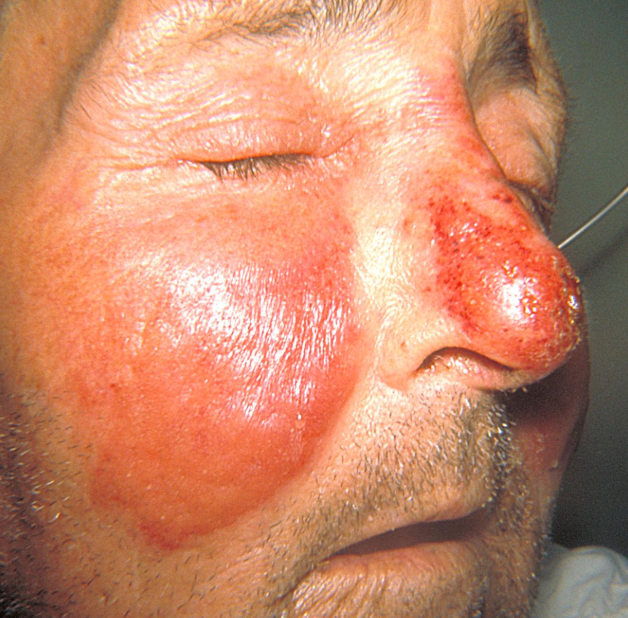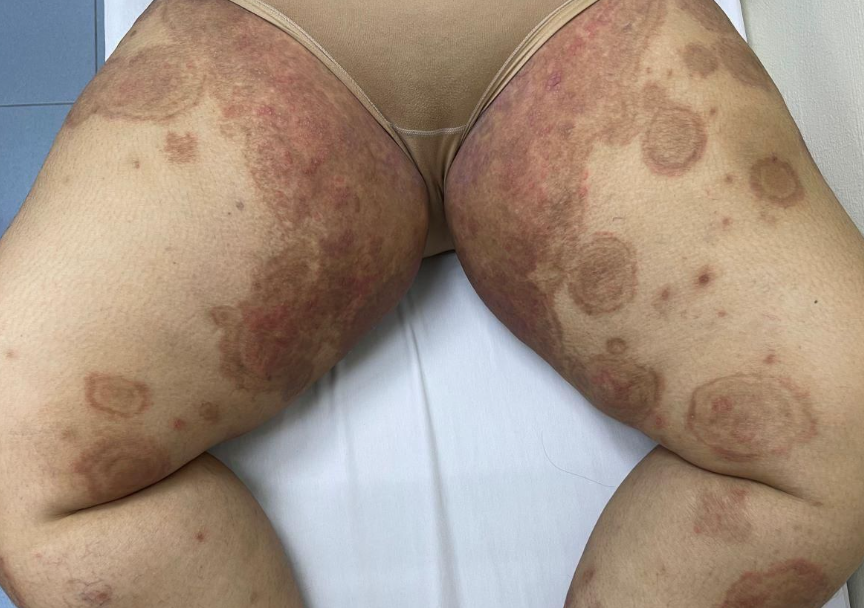Dermatology 4
1/9
Earn XP
Description and Tags
26/05
Name | Mastery | Learn | Test | Matching | Spaced |
|---|
No study sessions yet.
10 Terms
Erysipelas: definition, pathogenesis and manifestations
Erysipelas is an acute bacterial dermal and subdermal infection characterized by red, shiny, raised, spreading plaques with well-demarcated edges. It is caused by Streptococcus group A and it needs a portal of entry for the infection, which can be a small skin lesion or tinea pedis. The classical sign is the step sign, which refers to the characteristic sharp se
paration between the healthy skin and the infected skin area, which has well-demarcetd borders. Touching the plaque, it is possible to feel a palpable raised plaque.

List and explain 3 possible environmental triggers for psoriasis
Infections: Streptococcal throat infections are a well-known trigger for guttate psoriasis.
Trauma: physical injury or trauma to the skin (e.g., cuts, sunburn, or scratches) can trigger the onset or worsening of psoriasis in a phenomenon known as the Koebner phenomenon.
Vitamin D deficiency: Vitamin D has both significant immunomodulatory effects and anti-inflammatory effects. It promotes the differentiation of regulatory T cells (T-reg), which help maintain immune tolerance and prevent excessive inflammatory responses and is also expressed in keratinocytes, regulating their proliferation and differentiation. Vitamin D exerts anti-inflammatory effects by downregulating pro-inflammatory cytokines such as IL-17, IL-22, and TNF-α and thus is used as a drug in psoriasis.
Illustrate treatment of herpes zoster
High-dose acyclovir (800 mg 5 times daily for 7 days) within 72h of the onset of the eruption.
If the eye is affected/there is nerve compression: intravenous acyclovir (5 mg/kg every 8h for 5 days) should be considered, and patients may require systemic steroids (prednisolone 40–60 mg daily) to prevent nerve paralysis in severe cases.
Vitamin B supplements to reduce the risk of post-herpetic neuralgia (PHN).
Why does pityriasis versicolor leave vitiligoid spots that disappear at the end of the treatment and sun re-exposure (after treatment)?
Malassezia produces azelaic acid, a compound that inhibits tyrosinase, the enzyme responsible for melanin production. This leads to temporary hypopigmentation in affected areas, and in fact, Pityriasis versicolor became initially apparent as pale spots that fail to tan in the sunlight. This effect is temporary, and melanocytes gradually resume normal function after treatment.
Write the differential diagnosis between Erythrasma and Tinea cruris in their etiology, clinical appearance and diagnostic tests
TINEA CRURIS:
Dermatophytes
Yellowish-brownish, scaly patches with well-defined, raised borders and central clearing.
It’s often bilateral and symmetric.
Wood’s lamp: positive for yellow-green fluorescence.
Culture: can identify dermatophytes.

ERYTHRASMA:
Corynebacyterium minutissimum (gram-positive)
Coral red patches with poorly defined margins and fine scaling.
Often unilateral and asymmetric.
Wood’s lamp: positive for coral red fluorescence
Gram stain and culture: can confirm Corynebacterium minutissimum

List at least 3 cutaneous diseases associated with type IV hypersensitivity reactions
Allergic contact dermatitis
Atopic dermatitis (overlapping with type 1)
Psoriasis (innate immunity with type 4)
What are the possible clinical skin manifestations of type I/II/III/IV hypersensitivity reactions?
Type I: wheals
Type II: blisters
Type III: erythematous macula that does not disappear under pressure
Type IV: eczema
What is the main germline mutation of melanoma?
The main germline mutation in melanoka affects the CDKN2A locus on chromosome 9p21. When CDKN2A is mutated or deleted, there is a loss of function of its two tumor suppressor proteins p14 and p16, which normally act as negative regulators of cell cycle progression. With this mutation, as a result, there is unchecked cell proliferation and tumor development.
What distinguishes scarring from non-scarring alopecia?
Irreversible follicle destruction and replacement with fibrous tissue
During which phase of the hair cycle does apoptosis-driven follicular regression occur?
Catagen phase.